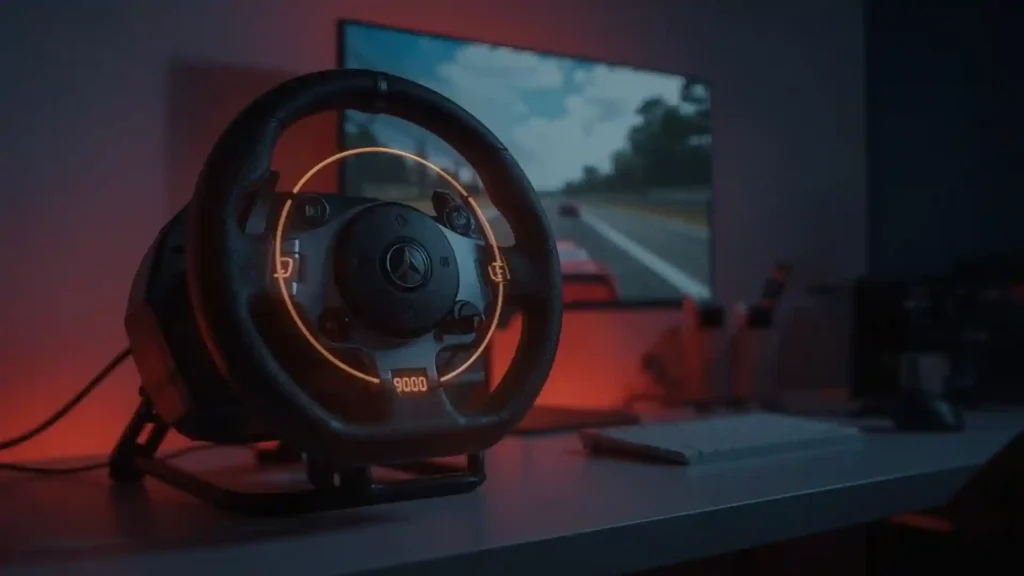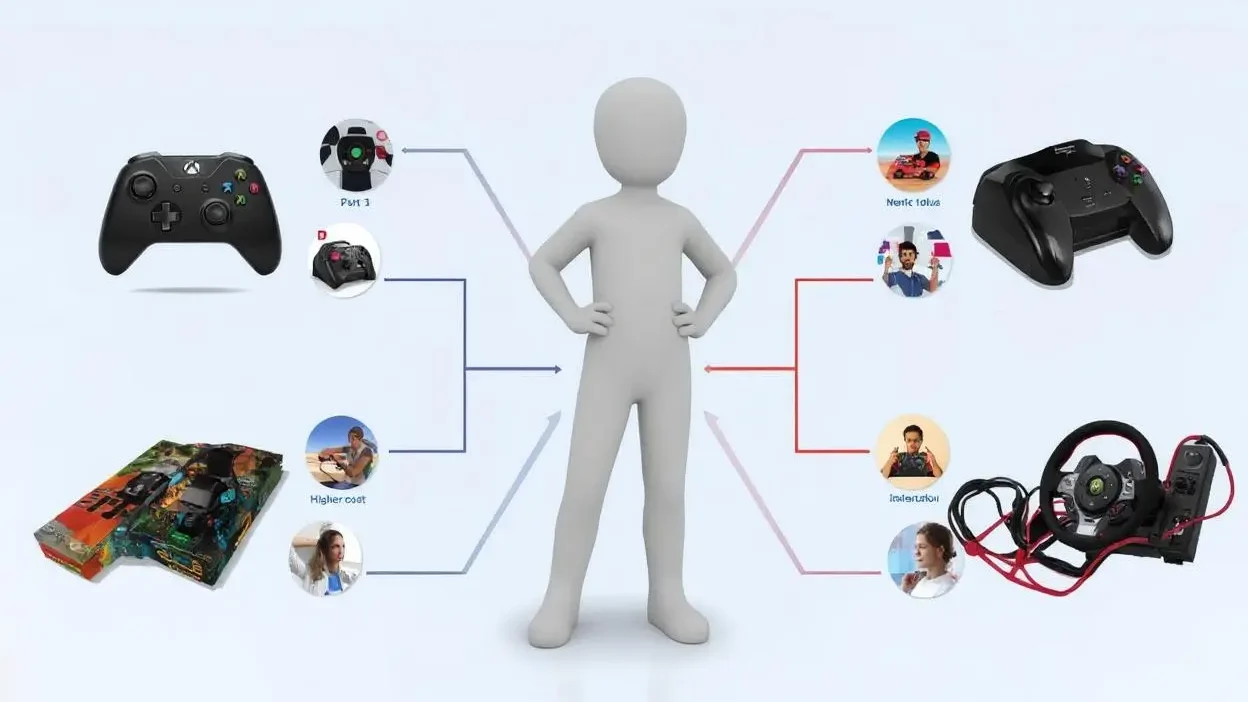
Do You Need a Wheel for Racing Simulator as a Beginner?
Racing simulators have gained popularity over the past few years because of two main reasons: fewer arcades, and compact racing simulator gear. The thrill of virtual racing is fulfilled by these gears, but new players often get stuck on one big question: how can I get the bang for the buck gear?
If you join different sim racing communities, you’ll hear racers arguing about different hardware accessories. Some racers say you can’t experience proper sim racing without a wheel. Others argue that controllers work just fine for beginners. At the end of the day, its YOUR choice.
Do beginners really need a racing wheel to enjoy their first racing simulator experience? The answer might surprise you.
Gaming Tech Series breaks down the real pros and cons of starting with a wheel for your racing simulator. We’ll explore sim racing without wheel options, examine it, and give you practical advice based on your budget and goals. By the end, you’ll know exactly what equipment makes sense for your situation.
What Is a Racing Wheel and Why Is It Popular?
A racing wheel is an electronic hardware accessory that is shaped and has functions like a real steering wheel. If we talk about the entire combo for a racing simulator, that specific racing wheel setup consists of three main parts: the steering wheel itself, a set of pedals for gas and brake, and sometimes a gear shifter.

Just like a real car in your room, but without the entire body. The wheel spins 900 degrees just like a real steering wheel, while the pedals respond to pressure like actual car pedals.
Racing wheels have become the gold standard of racing simulators as they create an unforgettable experience. When you turn the wheel, you feel resistance and feedback through force feedback motors, imitating the real steering wheel and force while you drive. Hit a curb too hard, and the wheel jolts in your hands. This realistic control makes every racing simulator feel more authentic.
One of the most popular beginner options includes the Logitech G29, and Thrustmaster T150. These wheels balance quality with reasonable prices, making them perfect starting points for new sim racers.
For a complete breakdown of racing simulator components and setup basics, check out our beginner setup guide.
Pros of Using a Racing Wheel as a Beginner
| Advantage | Explanation |
| Realistic Driving Experience | Better steering feel and precision |
| Improved Control and Accuracy | Analog input beats keyboard/controller |
| Immersive Experience | Force feedback adds to realism |
| Learning Benefits | Develop better racing skills w.r.t real cars |
Cons of Using a Racing Wheel as a Beginner
| Disadvantage | Explanation |
| Cost | Expensive ($200+) |
| Setup Complexity | Space needed for rig or desk mounting |
| Learning Curve | Tricky at first compared to controllers |
| Compatibility | Not all wheels work with every sim or platform |
Alternatives to Racing Wheels for Beginners

Game Controllers: Xbox and PlayStation controllers offer the most accessible entry point into sim racing without wheel setups. Quality controllers cost around $20+ compared to $200+ for entry-level wheels, making them perfect for testing the waters.
The experience with controllers is surprisingly engaging. Modern controllers feature dual shock motors that create vibrations when you hit walls, go over bumps, or lose traction, so yeah, you are having some immersive experience at least. The analog triggers provide smooth acceleration and braking control, while the thumbstick handles steering with decent precision.
However, controllers do have limitations. Steering feels less natural since you’re using a small thumbstick instead of a full wheel. Fine adjustments become trickier, especially in tight corners or during precise overtaking moves. The vibrations obviously can’t match the force feedback of a proper racing wheel.
Hybrid Approaches: Many sim racers start with controllers. This approach lets you learn racing fundamentals without a big upfront investment. You can discover which racing simulator games you enjoy, then decide if a wheel upgrade makes sense for your favorite titles.
When Should a Beginner Consider Getting a Wheel

Your racing goals matter most when choosing beginner sim racing gear. Casual players who race occasionally can have plenty of fun with controllers. But if you’re a bit competitive, then a wheel for your racing simulator is necessary.
Budget plays a huge role too. Racing wheels need desk space or a dedicated rig, plus $200-500 for decent setups. Controllers work anywhere and cost much less.
Consider the racing simulator games you love. Formula 1 and hardcore sims like iRacing demand precision that wheels provide. Arcade-style racers work fine with controllers.
Your personal commitment level decides everything. If sim racing feels like a passing interest, start with a controller. But if you find yourself racing for hours and craving more immersion, a racing wheel transforms the entire experience into something memorable.
5 Tips for Beginners Choosing Their First Racing Wheel
- Look for force feedback features.
- Check compatibility with your platform.
- Consider pedals included vs separate purchase.
- Read beginner-friendly reviews and watch video comparisons.
- Look for wheels with good value for money.
Recommended Entry-Level Racing Wheels for Beginners (2025 Update)
Closure
You don’t need a racing wheel to start your racing simulator journey, but it’s highly recommended for serious beginners. Controllers offer a budget-friendly way to explore sim racing without wheel setups, while wheels provide unmatched immersion and precision.
Consider your budget, available space, and racing goals before deciding. Start with whatever feels comfortable and fits your situation. Many successful sim racers began with controllers and upgraded later as their passion grew.
The key is getting started, not having perfect beginner sim racing gear from day one.
Share your racing simulator setup experience in the comments below, or explore our other beginner guides for complete racing simulator advice.
FAQs for Racing Simulator Without a Wheel
- Can I play sim racing without a wheel?
Yes, absolutely. Most racing simulators work perfectly with Xbox or PlayStation controllers. You’ll miss some precision and immersion, but many players enjoy sim racing this way. - Is a wheel better than a controller for beginners?
Wheels offer more precision and realistic feedback, but controllers are easier to learn and much cheaper. Start with what you can afford and upgrade later. - What’s the cheapest racing wheel worth buying?
The Logitech G29 or Thrustmaster T150 are excellent entry-level choices around $200-250. Avoid wheels under $150 as they usually lack proper force feedback. - How do I set up a wheel for sim racing?
Install the wheel’s software, connect via USB, calibrate in your racing game’s settings, and adjust force feedback strength to your preference. Most wheels include setup guides.
